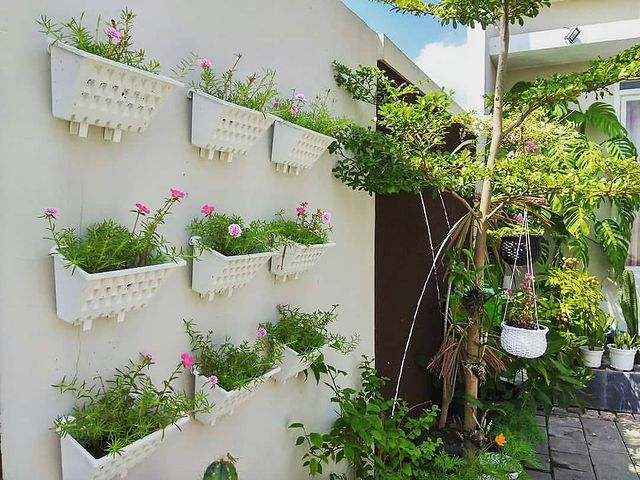A vertical garden, also known as a living wall or green wall, is a fantastic way to maximize space in your yard while adding beauty and greenery. This innovative design allows you to grow plants vertically, utilizing walls or structures to create a vibrant and lush garden. Here are some key points to consider when designing a vertical garden:
Select the Right Location
Choose a suitable location in your yard that receives adequate sunlight and has a sturdy vertical surface, such as a wall or fence. Consider the plants’ sunlight requirements and ensure they will thrive in the chosen spot.
Plan the Structure
Determine the size and structure of your vertical garden. You can opt for prefabricated vertical garden systems or create a custom design using containers, shelves, or trellises. Plan the layout to maximize the available space and ensure proper support for the plants.
Choose the Plants Wisely
Select plants that are well-suited for vertical growth. Consider their size, growth habits, and light requirements. Opt for a mix of cascading, trailing, and upright plants to add visual interest and variety to your garden. Herbs, succulents, ferns, and flowering vines are excellent choices for vertical gardens.
Provide Adequate Irrigation
Vertical gardens require proper irrigation to ensure the plants receive sufficient water. Install a reliable watering system that allows for easy maintenance and prevents water runoff. Consider using a drip irrigation system or self-watering containers to conserve water and promote plant health.
Enhance Drainage
Ensure your vertical garden has proper drainage to prevent waterlogging and root rot. Use well-draining soil or a specialized growing medium designed for vertical gardens. Additionally, incorporate drainage holes or a drainage system to allow excess water to flow out of the structure.
Maintain the Garden
Regular maintenance is crucial for the health and longevity of your vertical garden. Trim and prune the plants as needed to maintain their shape and prevent overcrowding. Monitor the irrigation system, fertilize appropriately, and address any pest or disease issues promptly.
Consider Lighting
If your vertical garden is located in a shaded area, consider incorporating artificial lighting to supplement natural light. LED grow lights can provide the necessary light spectrum for plant growth and allow you to cultivate a wider range of plants.
Add Decorative Elements
Enhance the aesthetics of your vertical garden by incorporating decorative elements. Hang outdoor artwork, install decorative containers, or include hanging lanterns to create a visually appealing and inviting space.
Utilize Edible Plants
Consider growing edible plants in your vertical garden to create a functional and sustainable space. Herbs, salad greens, and strawberries are excellent choices that can be harvested and enjoyed directly from your garden.
Experiment with Design
Don’t be afraid to get creative with your vertical garden design. Play with different plant arrangements, textures, and colors to achieve a visually stunning result. You can also incorporate other elements like small water features or vertical garden accessories to further enhance the overall design.
Vertical Garden Ideas
A vertical garden offers a unique and space-efficient way to bring nature into your yard. With careful planning, proper plant selection, and regular maintenance, your vertical garden can transform your outdoor space into a lush and vibrant oasis.
